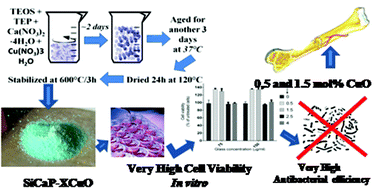Bioactive and biocompatible copper containing glass-ceramics with remarkable antibacterial properties and high cell viability designed for future in vivo trials
Abstract
In the present study our interest is focused on finding the efficiency of 60SiO2·(32 − x)CaO·8P2O5·xCuO (mol%) glass-ceramics, with 0 ≤ x ≤ 4 mol%, in terms of bioactivity, biocompatibility, antibacterial properties and cell viability in order to determine the most appropriate composition for their further use in in vivo trials. The sol–gel synthesized samples show a preponderantly amorphous structure with a few crystallization centers associated with the formation of an apatite and calcium carbonate crystalline phases. The Fourier Transform Infrared (FT-IR) spectra revealed slightly modified absorption bands due to the addition of copper oxide, while the information derived from the measurements performed by transmission electron microscopy, UV-vis and electron paramagnetic resonance spectroscopy showed the presence of ions and metallic copper species. X-Ray photoelectron spectroscopic analysis indicated the presence of copper metallic species, in a reduced amount, only on the sample surface with the highest Cu content. Regarding in vitro assessment of bioactivity, the results obtained by X-ray diffraction, FT-IR spectroscopy and scanning electron microscopy, demonstrated the formation of a calcium phosphate layer on all investigated sample surfaces. The inhibitory effect of the investigated samples was more significant on the Pseudomonas aeruginosa than the Staphylococcus aureus strain, the sample with the lowest concentration of copper oxide (0.5 mol%) being also the most efficient in both bacterial cultures. This sample also exhibits a very good bactericidal activity, for the other samples it was necessary to use a higher quantity to inhibit and kill the bacterial species. The secondary structure of adsorbed albumin presents few minor changes, indicating the biocompatibility of the glass-ceramics. The cell viability assay shows a good proliferation rate on samples with 0.5 and 1.5 mol% CuO, although all glass-ceramic samples exhibited a good in vivo tolerance.


 Please wait while we load your content...
Please wait while we load your content...